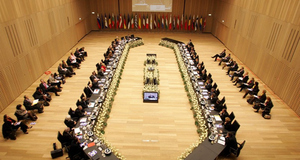From Earth Common Journal VOL. 3 NO. 2A Stakeholder's Perspective on the Implications of IFRS and Fair Value Accounting on Valuation of SecuritiesV. AuditorsThe main duty of an auditor is to verify that financial statements are representational and accurate, so as to avoid material misstatement (Smieliauskas & Bewley, 2013, pp. 8-9). Given this aim, auditors are charged with verifying valuations provided by clients, by ascertaining additional valuations for securities. These valuations can be problematic to establish under the framework of fair value accounting. Fair value accounting presents complications to auditors including difficulties with the measurement of assets, the need for extensive professional judgment, and disclosure issues when valuation is questionable (IAASB, 2008, p.4). In order to verify an asset’s value when using fair value methods, other professionals may need to be contracted to assist with determining an accurate assessment. These professionals may be required to use assessments of the market and their own judgment or in the case of illiquid markets they may use valuation models (Barnes, 2001, p.8). The highly subjective nature of this process makes it difficult for auditors to replicate and verify (IFAC, 2008, p.7). This further complicates the valuation process beyond that which existed when historical cost was employed. Fair valuation makes an auditor’s job of verification much more complex, as it dictates that he or she be able to issue assurance that the assets are valued correctly. This involves making assessments on the classification of assets, as well as their valuation (IFAC, 2009, p.4). In the case of historical cost method, auditors were responsible for determining that the asset was being held at the correct cost and was not inflated or deflated from its historical cost. This process was far less complex and the valuation figures were much easier to verify. As IFRS 13 and fair value accounting allow for a significant amount of flexibility in professional judgment upon initial valuation, which can be problematic for an auditor. This can present issues because the auditor may not have access to the professional who initially made the valuation. In such situations, the auditor may be required to make assumptions regarding the valuation (IFAC, 2008, p.6). This process inherently poses risks to the reliability of auditor’s assertions. However, it is likely that these issues will diminish as auditors and professionals become more cognizant of the new requirements for valuation. Issues with disclosure also arise due to fair valuation methods. Auditors must assess the risk of misstatement, and disclose areas in which they have concerns regarding the accuracy of a client’s assertions (Smieliauskas & Bewley, 2013, p.170). Because of the issues surrounding the reliability of information surrounding valuations, it is possible that it will be more unlikely that auditors will be able to offer unqualified audit reports, even to companies that have proceeded with careful and ethical valuation of their assets (IAASB, 2008, p.7). However, this should not be presented as an unresolvable issue. Given sufficient time and experience, auditors and clients should be able to build a system of more easily verifiable fair valuation methods, as both parties gain more experience with the requirements imposed upon them by IFRS 13. Auditors operating under fair value assumptions have a great number of additional challenges in assuring the reliability and accuracy of the valuation (IAASB, 2008, p.5). However, these challenges do not make fair valuation impossible for auditors. Fair value accounting in its present iteration may increase the amount of time an auditor will spend verifying client assets, but this is not an indication that this valuation method is flawed (IAASB, 2008, p.3). Once auditors have gained more experience with the requirements of fair value, and clients have grown accustomed to the level of verifiability that they should demand for their valuations, these stakeholders will be able to work within the methodology together, to produce financial statements that are accurate, reliable and verifiable. VI. Discussion and RecommendationsDespite controversies surrounding the use of IFRS 13’s fair value accounting methodology, it is our opinion that fair valuation remains the best method for assessing the value of financial instruments. This valuation method offers the most reliable and accurate representation of a firm’s value in current market conditions. It gives investors a reliable assessment of the firm’s performance and is not impacted by erroneous information on an assets previous valuation. However, IFRS 13 does not offer a perfect version of fair value accounting, and as such it should be amended in order to yield more reliable, relevant and representationally faithful financial statements and valuations with less reliance on professional judgment. Assessments that use fair valuation can cause contagion and severely damage the market are flawed; they fail to accept the basic premise of market forces. There is no need to conceal the reality of market conditions in order to bolster firm valuation. By using historical cost valuations in depressed markets, institutions are in essence intervening in the market by attempting to improve performance by concealing market information. It seems improbable that given the use of correct write-downs and accurate valuations, there would be any way that marking securities to market would cripple or even wound the international financial markets. Furthermore, it is the authors’ opinion that fair valuation does not impact market performance of a firm, but rather accurately represents it in financial statements. Through the use of fair value accounting, investors will be better equipped to make sound investment decisions given accurate information. The goal of accurate valuation for investment products is one that cannot be accomplished through the implementation of IFRS 13 and fair value accounting alone. As argued by Jeanjean and Stolowy, standards setters should also take other factors into account, when striving towards a common system that supports reliable, relevant, and representationally faithful valuation. These factors include attempting to ensure uniform application of standards (including legal sanctions and enforcement), and more coordinated competition rules across different markets (2008, p.16). Implementation of fair value accounting through IFRS does not in and of itself assure that the standards will be applied uniformly or correctly across, and within markets. The current status of the implementation of IFRS 13 and fair value accounting (along with asset classification) is one that is focused more on gaining support for the methodology and less on assuring that it is applied consistently and correctly. In order for fair value accounting to offer better accuracy of valuation and financial statements, proponents of the method should endeavor to create a better system of monitoring and sanctioning its implementation. The stock market regulators of each IFRS member nation (such as the Securities Exchange Commission in the United States) could administer this system of observation and sanctions. The presence of an overseer would encourage firms to strictly adhere to the rules set out by the IFRS regarding classification and valuation of securities. Auditors would also play a large role in assuring that fair value accounting was uniformly applied. Similarly to how they presently report fraud to appropriate authorities, auditors could become responsible for reporting incorrect application of fair value accounting methods. The presence of monitoring and sanctions for fair value accounting application would serve to encourage all firms to implement this practice correctly, and would increase investor confidence in the market overall. IFRS 13 allows for a significant amount of professional judgment with respect to the application and usage of accounting financial reporting standards (Zack, 2009. P. 13). This decrease in explicit guidance (with respect to GAAP and previous iterations of IFRS) can cause problems with consistency when applying classifications and assigning valuations. In order to assure that the advantages of fair value accounting principles are realized, standards setters must commit more time and lobbying efforts to standardizing application of the methodology across and within markets. Until the role of professional judgment is removed or decreased in IFRS, it will be difficult to achieve complete consensus among professionals with respect to the application of fair value accounting. In order to remedy this, it is the authors’ recommendation that the influence of professional judgment in future versions of IFRS, be decreased. This professional judgment allows for inconsistencies across users and harms the ability of fair value accounting to yield reliable, relevant and representationally faithful valuations and financial statements. VII. ConclusionThe adoption of fair value accounting and IFRS holds many advantages for businesses. Given the already widespread acceptance of this methodology, it will allow businesses to present their valuation in such a way that it is directly comparable with competitors (IFRS, 2013, para. 5). This can hold the advantage of increasing consumer confidence in the reliability and accuracy of a firm’s valuation, and consequently improve their share price and market value. As stakeholders become more versed in the requirements of fair valuation, the method will become easier to implement. The increased usage of fair value accounting will serve to improve transparency and reliability of valuation and financial statements across markets. Coupled with improvements to the current iteration of IFRS, fair value accounting will provide users of financial statements the most accurate and reliable information. Operating within the global marketplace, fair value accounting has the power to improve the markets’ ability to operate without intervention, by enhancing the quality of information and helping investors to become better, more informed participants in the free market. AuthorsGlynis Milne is a recent graduate of the Bachelor of Commerce program (Accounting maj.) at MacEwan University. Prior to beginning her accounting studies she earned a Bachelor of Science (Human Ecology) from the University of Alberta. Glynis’ interests in accounting include financial standards, risk analysis, and valuation for securities. She will begin her public accounting career this fall, where she will be pursuing her Chartered Account designation. Author/Advisor Dr. Eloisa Perez de Toledo is an assistant professor in the School of Business, Bachelor of Commerce at MacEwan University. ReferencesAmerican Bankers Association. (2013). Fair value and mark to market accounting. Retrieved from http://www.aba.com/Issues/Index/Pages/Issues_FairValue.aspx. Armstrong, C., Barth, M., Jagolinzer, A., & Riedl, E. (2009). Market Reaction to the adoption of IFRS in Europe. Accounting Review, Forthcoming. Ball, R. (2006). International Financial Reporting Standards (IFRS): pros and cons for investors. Accounting and business research, 36(sup1), 5-27. Barnes, R. (2002). Earnings volatility and market valuation: An empirical investigation. LBS Accounting Subject Area Working Paper No. ACCT019. Chasan, Emily (2008). Is fair value accounting really fair? Retrieved from http://www.reuters.com/article/2008/02/26/us-column-lifting- idUSN1546484120080226. Curtis, A., & Lewis, M. (2011). The comparability of accounting rates of return under historical cost accounting. Available at SSRN 1660671. Deloitte LLP. (2007). International financial reporting standards for U.S. companies: Implications of an accelerating global trend. Retrieved from http://www.deloitte.com/assets/Dcom- UnitedStates/Local%20Assets/Documents/us_assurance_international_financial_r eporting_std%20_030108(1).pdf. Fahnestock, R. T., & Bostwick, E. D. (2011). An analysis of the fair value controversy. Proceedings of ASBBS at Las Vegas, 18(1), 910-921. Financial Accounting Standards Board. (2013). Facts about FASB. Retrieved from http://www.fasb.org/jsp/FASB/Page/SectionPage&cid=1176154526495. IACPA. (2013) International financial reporting standards. Retrieved from http://www.ifrs.com/updates/aicpa/ifrs_faq.html#q4. International Auditing and Assurance Standards Board (2008). Staff audit practice alert. Retrieved from http://www.ifac.org/sites/default/files/downloads/staff_audit_practice_alert.pdf2008. International Auditing and Assurance Standards Board (2009). Emerging practice issues regarding the use of external confirmations in audit of financial statements. Retrieved from http://www.ifac.org/sites/default/files/downloads/iaasb_staff_audit_practice_aler t_external_confirmations.pdf. IFRS Foundation. (2013). About the IFRS foundation and the IASB. Retrieved from http://www.ifrs.org/The-organisation/Pages/IFRS-Foundation-and-the-IASB.aspx. IFRS Foundation (2012). IFRS 13 fair value measurement. Retrieved from http://www.ifrs.org/IFRSs/Documents/IFRS13.pdf. Jeanjean, T., & Stolowy, H. (2008). Do accounting standards matter? An exploratory analysis of earnings management before and after IFRS adoption. Journal of accounting and public policy, 27(6), 480-494. KPMG LLP. (2010) IFRS compared to Canadian GAAP: an overview. (3rded.) 2010. Retrieved from http://www.kpmg.com/Ca/en/IssuesAndInsights/ArticlesPublications/Document s/IFRS IFRSGAAPComparisonThirdEd2009-10.pdf. Laux, C., & Leuz, C. (2009). The crisis of fair-value accounting: Making sense of the recent debate. Accounting, organizations and society, 34(6), 826-834. Laux, C., & Leuz, C. (2009). Did fair-value accounting contribute to the financial crisis? (No. w15515). National Bureau of Economic Research. PWC. (2008). Fair value accounting: Is it an appropriate measure of value for today’s financial instruments? Retrieved from http://www.pwc.com/en_US/us/point-of view/assets/pwc_pointofview_fairvalue.pdf Shaffer, S. (2012) Evaluating the impact of fair value accounting on financial institutions: Implications for accounting standards setting and bank supervision. Retrieved from http://www.bos.frb.org/bankinfo/qau/wp/2012/qau1201.htm Securities Exchange Commission. (2013). The Investor's advocate:How the SEC protects investors, maintains market integrity, and facilitates capital formation. Retrieved from http://www.sec.gov/about/whatwedo.shtml Smieliauskas, W., Robertson, J. C., & Bewley, K. (2010). Auditing : An international approach / Wally J. Smieliauskas, Kathryn Bewley. Toronto : McGraw-Hill Ryerson, c 2013. Venkatachalam, M. (2000). Discussion of corporate disclosure practices, institutional investors, and stock return volatility. Journal of Accounting Research, 38, 203-207. Zack, G. M. (2009). Fair value accounting fraud: New global risks and detection techniques / Gerard M. Zack. Hoboken, N.J. : John Wiley & Sons, c 2009. Suggested Reading from Inquiries Journal
Inquiries Journal provides undergraduate and graduate students around the world a platform for the wide dissemination of academic work over a range of core disciplines. Representing the work of students from hundreds of institutions around the globe, Inquiries Journal's large database of academic articles is completely free. Learn more | Blog | Submit Latest in Economics |



















